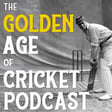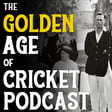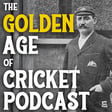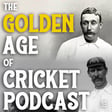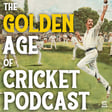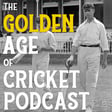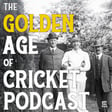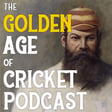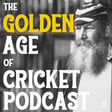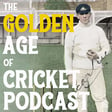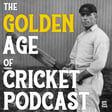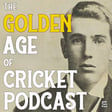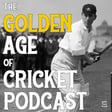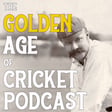Become a Creator today!Start creating today - Share your story with the world!
Start for free
00:00:00
00:00:01

Short Leg – 1st Test of 1894/95 at the SCG, Australia v England – Part 2
This episode of 'Short Leg' is Part 2 of Tom looking back on the famous 1st Test at the SCG of 1894, in which Australia hosted Andrew Stoddart's England side. The match is often credited with being the first great match of the new era, and one that saw many new records established.
CREDITS:
Presenter & Producer: Tom Ford
All music used in podcast comes from the University of California Santa Barbara's remarkable collection of wax cylinder's from the late nineteenth and early twentieth centuries, which are free to download and use. You can donate to the upkeep of these recordings via their website.
Transcript
Sydney Test 1894: An Epic Clash Begins
00:00:07
Speaker
Welcome to part two of this Short Lake episode on the famous Sydney Test match of 1894 between Australia and England. My name is Tom Ford. We finished part one at Stumps on day two with England 3 for 130.
Rain's Impact: The Sticky Wicket Phenomenon
00:00:34
Speaker
The next day was a Sunday, and so it was a rest day for the players, that is, no play. This custom continued, albeit not always exclusively on a Sunday, well into the 20th century. The rain which threatened its stumps on day two appeared on the rest day, and even on the morning of the official third day's play, the Monday.
00:00:55
Speaker
This was an age before cricket pitches had covers, so overnight rain affected the pitch to the batsman's eye and the bowler's delight. Once the rain had passed and play resumed, a pitch exposed to the sun would become sticky as the players and fans came to call it, causing the ball to rise and break off the pitch to devastating effect.
00:01:17
Speaker
An 1884 update to the official laws of the game officially banned the use of covers once a match had commenced. Thus, the so-called golden age of cricket was rife with sticky wickets and players had to adapt as best they could. Especially in England where summer rainfall was more prevalent, many matches endured sticky wickets. Old-timers believed it created a greater and more balanced contest between bat and ball.
00:01:46
Speaker
When Australia began the practice of covering wickets in the 1920s, it was no coincidence that it consequently saw the commencement of the age of Bradman and Bill Ponsford, enormous run scoring machines who benefited from flat, easier to bat on wickets.
Day 3: England's Struggle and Follow-on
00:02:02
Speaker
Anyway, I digress. Back to December 1894.
00:02:10
Speaker
The fourth day overall was the official day three and a Monday and as a result the attendance was about half of which had appeared on the Saturday. Ward and Brockwell resumed England's innings at 3 for 130 and fought off an opening spell of bowling with a jury ball.
00:02:29
Speaker
opener Ward eventually fell to Charlie Turner for 75. Bobby Pil resisted little and was even dropped early by Jones at slip, but was soon dismissed when caught by local hero Gregory off the bowling of Giffen for just four runs. England in trouble at five for 155, still 431 runs behind.
00:02:50
Speaker
Brockwell and new batting partner Ford added 56 runs in the middle session, before the latter was cleverly stumped by Captain Blackham, again off the bowling of Giffen.
00:03:00
Speaker
Almost immediately after, Ernie Jones took his first test wicket when he removed Brockwell, one short of his half-century. England now seven down for 211 runs. The visitors needed its tail to wag, and luckily for them it did. First Briggs played a cameo innings of 57, and wicket-keeper Leslie Gay made up for his numerous errors behind the stumps in the Australian innings with 33.
00:03:26
Speaker
Bowler Bill Lockwood, who had contributed little to England's cause due to his shoulder injury in the field, even made an important 18 runs, before England were all out for 325. 261 runs behind the Australian turtle and asked to follow on. With the wicket becoming increasingly sticky as the sun dried the pitch out, an innings defeat for England looked even more likely.
England's Resurgence: A Turning Point
00:03:54
Speaker
Crucially, during the final session of day three, Australia's keeper Blackham had copped a blow on his thumb from a delivery from part-timer Jack Lyons, which split it open. Unable to keep properly, Charlie McLeod was forced to take the gloves. As England were dismissed close to stumps, it was decided to end the day then and there, with the visitors beginning their second innings first thing on day four.
00:04:20
Speaker
In the 19th century, these international tours were often seen as money-making ventures for the visitors, relying on gate keepings to make the trip worthwhile, especially for the so-called shamatures in the side. According to writer David Frith, England's Archie McLaren arrived on day four and saw that the visitors were 50 to 1 to win, so placed four pounds on his side. Again, how times have changed.
00:04:47
Speaker
The weather was cloudy rather than sunny in Sydney on this day, which enabled the pitch to settle, instilling greater confidence in the English batters than in the first innings.
00:04:57
Speaker
As the Sydney Morning Herald reported, runs at the start came very slowly for the Englishman, who knew what was before them. A steady opening from McLaren and Ward put 44 on the board, before McLaren was bowled by that man again George Giffen, who had led the way in the first innings with four wickets, to say nothing of his 161 with the bat.
00:05:20
Speaker
Captain Stoddart and Ward then took the England total past 100 and Giffen should have had Ward caught behind, but substitute keeper McLeod let him off the hook as the injured Blackham watched on. Stoddart fell on 36th Charlie Turner and it was 2 for 115, still 146 runs short of Australia's mammoth total.
00:05:43
Speaker
Ward's let off proved pivotal as he continued to hammer the Australian bowling with a new partner, Brown, who also quickly found his form against a tiring Australian bowling lineup. Eventually, eight Australian bowlers were used, but none more stoically than the indefatigable George Giffen, who bowled a staggering 75 overs in this innings alone. More on this later.
00:06:08
Speaker
By tea, England had reached 183 for the loss of two batsmen, with Ward just two runs short of his sentry. As the final session began, Australia swapped wicket keepers again, as they couldn't do without McLeod's bowling any longer, so Johnny Reedman assumed the role behind the stumps. Ward reached his sentry soon after and was roundly applauded.
00:06:32
Speaker
Giffen continued on and eventually dismissed the Centurion for 117, and then Brown not long after for that for a cleverly made 53. England were 4 for 245, 16 runs short of Australia's total.
00:06:48
Speaker
With Peel and Brockwell taking England safely to Stupps on day 4, they finally surpassed the Australian total, finishing the day on 268 runs, a lead of 7 runs with 6 wickets remaining. Stoddart and his men would have known they'd need a larger total than that to trouble this strong Australian batting line up.
00:07:09
Speaker
The fifth day's play at the Sydney Cricket Ground wasn't necessarily the final day. This, like all test matches in Australia until 1937, was a timeless test, meaning they played until either side had a victory. Tests in England until
Day 5: The Timeless Test Format's Drama
00:07:25
Speaker
the late 1940s were three days in length only, except for the odd English test here and there, which accounted for the many draws in English tests during its early history, not to mention the weather.
00:07:38
Speaker
Despite a promising start, England's two overnight batsmen added only a few runs apiece before being sent back to the Pavilion. Brockwell clean-bowled by Jones for 37 and then Peel played onto his stumps off Giffen for 17. England were suddenly six for 296, a lead of just 35 runs. Francis Ford and Johnny Briggs then took command and saw the team to lunch with a partnership of 48 runs.
00:08:05
Speaker
Resuming after the break, they continued to grow England's lead, before McLeod, relieved of his keeping duties, broke through twice, first catching Ford off his own bowling for 48, and then rattling the stumps of breeze for 42. These vital runs from the middle and lower order of England saw their total reach 400, a lead of 139.
00:08:29
Speaker
Lockwood Gay and Richardson, who was battling a cold, all contributed handy runs and the England team were eventually dismissed in the afternoon for 437, meaning Australia had to chase down 177 for victory. Considering they almost hit 600 in the first innings, the players, press, crowd and dare I say English players thought it was Australia's match to lose.
00:08:53
Speaker
George
Day 6: Chaos and Collapse on a Sticky Wicket
00:08:54
Speaker
Gifford finished his 75th over to go with his 43 overs in the first innings, a total of 118 for the match, which is still a record for an Australian bowler in test matches against England. With two hours left of play on day five, Lions in trot strode to the wicket to face the English bowlers.
00:09:15
Speaker
Lions tried to reach the total immediately, swinging wildly at everything and, for a while, it worked. He raced to 25 before Richardson found his stumps. The more cautious Harry Trott poked and prodded for his runs, but he was caught behind of Bobby Peel when the total was 45.
00:09:35
Speaker
The tireless Giffen and young Joe Darling then took Australia to stumps looking soloed at 2 for 113 needing another 64 runs with eight wickets in hand. Even the most optimistic England supporter must have thought day six would be a walk in the park for the Australians but as clouds gathered above them they came upon the Australians just an ounce of doubt.
00:09:59
Speaker
Day 6 and the 7th overall has gone down in cricketing folklore. The Australians woke in full confidence and when they looked out the window it was confirmed that the 66 runs needed would be easy to achieve. As Ernie Jones exclaimed to his teammates at breakfast, it's alright boys, the weather is beautiful.
00:10:19
Speaker
It may very well have been, but as the wise Jack Blackham entered the room, he bore a face, it was recalled by George Giffen, as long as a coffee pot. He looked at the all-rounder with sad eyes and remarked, It's been pouring half the night, George. He knew better than his teammates at what it would mean in the rising Sydney sun.
00:10:41
Speaker
It had indeed rained all night, and before the era of covered wickets, it meant the wicket would be soft, soggy and vulnerable. A sunny day, as Jones and others had boasted about, would actually make it sticky, meaning it would be a huge advantage to the fielding side. Umpire Bannerman later reported to the Sydney Morning Herald that fast bowler Richardson was able to cut the ball off the pitch, a good foot in length.
00:11:09
Speaker
Arriving at the ground, Blackham's suspicions were realised. When Ned Gregory, Sid's father and the Sydney Cricket Ground curator, was asked by the Observer newspaper before the day's play what the pitch was like, he said, oh soft, you can stick your finger in it.
00:11:29
Speaker
It's been reported through the decades, although it appears more fanciful storytelling rather than fact, that some of the English cricketers had a wild night out the previous night to drown their sorrows at the prospect of losing the test.
England's Remarkable Victory and Records
00:11:42
Speaker
Bobby Peel in particular arrived at the ground still inebriated, much to the disgust of his captain Andrew Stoddart.
00:11:50
Speaker
One retelling also mentions his drunkenness, but puts it down to him having five teeth extracted the previous night, so his alcohol consumption was medicinal, not emotional. Either way, Stoddart needed to sober him up, especially with strike bowler Tom Richardson still not fully recovered from his illness. After a quick shower, legend has it that Peele said to his captain, give me the ball Mr Stoddart, I'll get the buggers out before lunch.
00:12:19
Speaker
Sport and hindsight often have a way of concocting such stories, and then they stick. Whether the drunkenness happened and shower prophecy actually said is irrelevant, because what happened on the field is even greater a story. The two South Australians, Giffen and Darling, resumed their partnership in front of a smaller Thursday crowd of about 1,500 paying customers, presumably because everyone assumed the result was given.
00:12:49
Speaker
Initially the batting pair looked in control. Darlene reached his half-century in his test debut before attempting to hit Peel out of the ground and was caught by Brockwell at Long Off. Five runs later and Giffen too was dismissed, this time LBW to Breeks. Australia were now four batsmen down and still needing 42 runs.
00:13:11
Speaker
The new batsmen were Frank Idow and first innings hero Sid Gregory. But the relentless bowling of Briggs and Peel on the increasingly impossible Sticky Wicket was becoming too much. First Idow hit a plum catch back to the bowl of Briggs and then Australia was in all sorts when Gregory was caught behind by the fumbling gay off Peel.
00:13:33
Speaker
Nineteen runs were still needed and only four wickets in hand. In the blink of an eye, England had arrested momentum. Readman, in what turned out to be his only test match, was unlucky to be stumped by Gay when the ball ricocheted off the keeper's chest onto the stumps for just four runs.
00:13:51
Speaker
In the pavilion, injured Captain Blackham was reported to have been pacing up and down, repeating the words, cruel luck, over and over again as the Australians collapsed. With Reidman's dismissal, 18 runs were still required. The next man in, Turner, managed just two runs before being caught by Briggs off-pill. Eight for 161. 16 runs still required.
00:14:17
Speaker
Ernie Jones came in and tried to blast his way to victory but only managed a single before being caught by McLaren off Briggs. Fifteen required and the injured Blackham with his thumb heavily strapped walked onto the test arena for the final time. He joined a helpless McLeod in the middle who had seen Reedman, Turner and Jones dismissed in quick succession.
00:14:40
Speaker
Black and poked and prodded for a couple of runs before the man of the hour, Bobby Peel, lured the Australian captain into driving down the ground, only for his hit to land in the hands of the bowler. Caught and bowled for two runs. Australia all out for 166. England won the test by 10 runs. Remarkably, Australia lost its last eight wickets for just 36 runs.
00:15:07
Speaker
The collapse was speedy and complete, wrote Sydney's Evening News. Wicket after wicket went down, and when the last fell, Australia was still 10 runs in the bad. Bobby Peel, drunk or not, was the hero with 6 for 67, ably supported by Briggs with 3 for 25.
00:15:29
Speaker
In his autobiography, with bat and ball from 1898, George Giffen explained, With 586 runs on the slate, we never for one second dreamt of losing the game. Such was the magnitude that many records were broken in this extraordinary test match. It was the first test to reach a sixth day. The total run scored, 1514, was a new record.
00:15:56
Speaker
Australia's first inning total was its highest on home soil. George Giffen became the first player to score a total of 200 runs or more and take 8 wickets in a single match. And for the first time, a side had won a test match, having been forced to follow on.
00:16:14
Speaker
Most remarkable
Series Outcome and Sportsmanship
00:16:15
Speaker
about this last statistic is that in the 130 years since, such a thing has only happened again three more times. England defeating Australia at Leeds in 1981, India defeating Australia at Colcutta in 2001, and New Zealand most recently when it defeated England at Wellington in 2023.
00:16:38
Speaker
Of course, what added to the fabled story of the 1894 test match was what followed. The remaining four test matches that summer led to a remarkable conclusion. Blackham, unable to recover from his split thumb, relinquished the captaincy and his place in the team. The keeping duties falling to South Australia's Affy Jarvis and Giffen ascended to captain.
00:17:01
Speaker
After a week's break over Christmas, the second test began at the Melbourne Cricket Ground. Each team was skittled out for small first inning totals before England captain Stoddard hit a career-high 173 to arrest control for the visitors, eventually winning by 94 runs. England 2-0 up in the series.
00:17:23
Speaker
On the 11th of January 1895 the third test began in Adelaide and the Australians won the match within four days by 382 runs thanks largely to a 140 hit by Frank Iredow in their second innings. This match is perhaps best remembered for the all-round debut of Harry Trott's younger brother Albert who hit more than a hundred runs across both innings and took eight for 43 opening the bowling in the second innings.
00:17:51
Speaker
The fourth test returned to Sydney in early February, and Australia again won, making up for its December calamity. This time it was a shellacking, winning by an innings and 147 runs having dismissed a deplorable England for 65 and 72 in each innings.
00:18:12
Speaker
With the series level at two wins apiece, it all came down to the fifth and final match in Melbourne. This match witnessed a great deal of run scoring as both sides were desperate for a win. Needing 297 runs in the fourth innings to win, England looked vulnerable at 2 for 28 before a 200-run partnership between Ward and Brown
00:18:33
Speaker
the latter scoring a famous 140, put the result beyond doubt. England won the match by six wickets. The series three games to two and retained the ashes. The local press praised Captain Stoddart and his team for their victory and the manner in which the series was played. The Adelaide advertiser even warned its readers that depression was now likely to set in that the series had ended.
00:19:00
Speaker
But of the 1894 Sydney Test match, Wisden, cricket's annual Bible, put it best. This was probably the most sensational match ever played in Australia or in England. And from our perspective 130 years later, it's still hard to argue with that.
00:19:21
Speaker
Thanks for listening to this Shortleg episode of the Golden Age of Cricket Podcast. Please leave a review on Apple Podcasts or wherever you choose to listen. Don't forget to follow or subscribe to this podcast so you may never miss an episode. My name is Tom Ford and until next time, it's bye for now.
